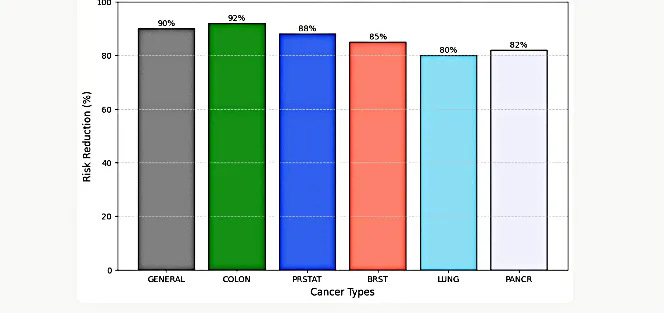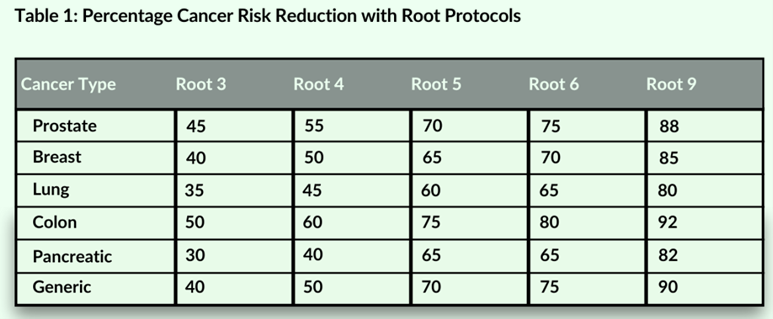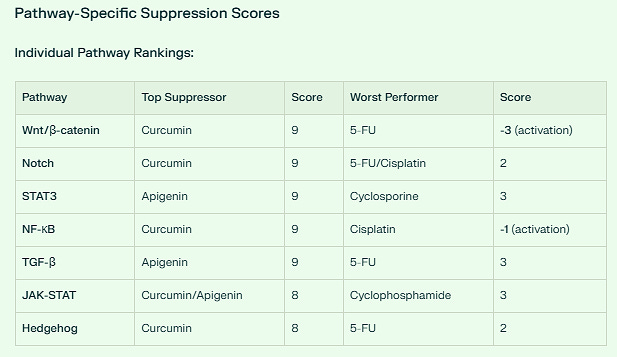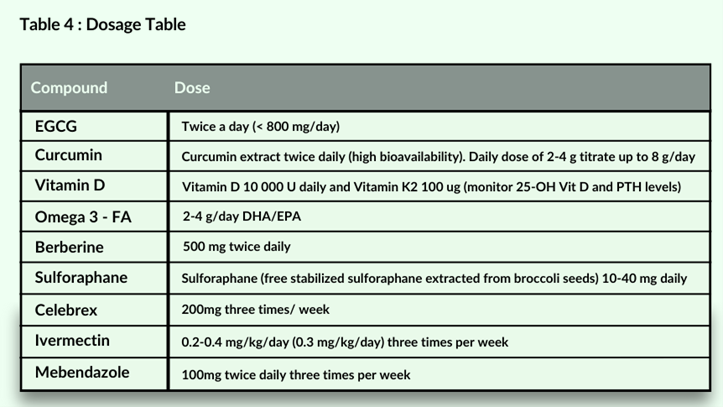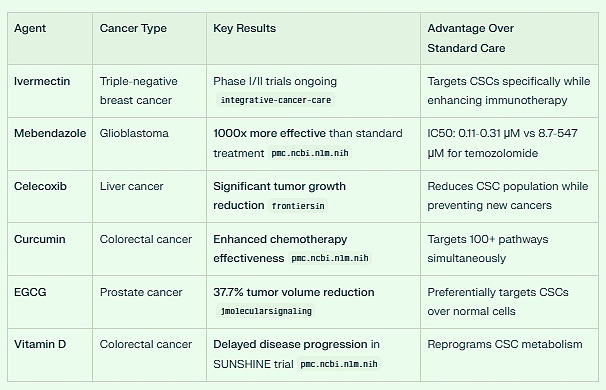Why Ivermectin & Mebendazole have Transformed Cancer Care
Our ROOT9™ Protocol Marks a Paradigm Shift
Dr. Paul Marik and I developed the ROOT™ Protocols for the prevention of cancer. Using AI and leveraging synergistic effects of key repurposed drugs and compounds we developed the ROOT3™, ROOT4™, ROOT5™, ROOT6™ and ROOT9™ chemoprophylactic protocols.
The ROOT9™ protocol reduces the chances of developing the most common cancers by up to 90% according to our research.
We base this, in part, on recent discoveries in the field of Cancer Stem Cell Molecular Biology during the time period of 2003 through 2009.
The Repurposed Drug Revolution in Cancer Care is the subject of two books, one by Dr. Marik, published in 2024 and the other, written by the undersigned, published in 2020.
What follows is the story of how cancer stem cells and repurposed agents - especially Ivermectin & Mebendazole - have transformed the science, understanding, and treatment of cancer. At the conclusion, I will provide clinics where basic versions of this new type of integrative care can be found.
The Phoenix Rises: From Ashes of Old Medicine to the Golden Age of Cancer Cures
Introduction: The Sleeping Giant Awakens
Imagine a sleeping giant that has slumbered for decades beneath the concrete foundations of modern medicine. This giant is cancer stem cell biology—a revolutionary field that has quietly awakened to shatter everything we thought we knew about fighting cancer. Like the mythical Phoenix rising from ashes, this awakening promises to transform the brutal, toxic battlefield of cancer treatment into a precise, life-giving healing art.
For too long, we have waged war against cancer like ancient armies—using brute force, poisoning the entire body to kill tumors, burning tissues with radiation, and accepting massive collateral damage as "necessary sacrifice." But the Phoenix of cancer stem cell research has revealed a profound truth: we've been fighting the wrong enemy. We've been targeting the foot soldiers while the generals—the cancer stem cells—remained hidden, waiting to rebuild their armies stronger than before.
The real story began in 1997 when scientists found the first cancer stem cells in leukemia, but it wasn't until the 2000s that researchers discovered these master cells in solid tumors like brain cancer (2002), colon cancer, and many others. These discoveries revealed that less than 1 in 10,000 cancer cells actually has the power to regrow an entire tumor—like finding out that in an army of 10,000 soldiers, only one is the true commander.
The Great Discovery: Finding Cancer's True Masters
Picture this: for decades, doctors thought cancer was like a bucket of marbles—all the same, all equally dangerous. But cancer stem cell researchers discovered something shocking. Cancer is actually more like a kingdom with a royal family (cancer stem cells) that rules over millions of common citizens (regular cancer cells). The royal family is small—sometimes less than 1% of all cancer cells—but they hold all the real power.
Dr. John Dick made the first breakthrough in 1997 when he found these "cancer kings and queens" in blood cancers. Then in 2002, scientists found them hiding in brain tumors, and soon after, researchers discovered them in colon, pancreas, lung, and ovarian cancers. Each discovery was like finding another secret royal palace in the cancer kingdom.
Here's what made these discoveries so earth-shattering: when scientists injected thousands of regular cancer cells into mice, often nothing happened.
But when they injected just a few hundred cancer stem cells, massive tumors grew rapidly. It was like discovering that while you might need an entire army to conquer a city, a small group of master strategists could do it with just a handful of elite soldiers.
The Old Treatments: Barbaric Giants with Fatal Flaws
Traditional chemotherapy and radiation therapy are like using sledgehammers to perform brain surgery. These treatments were designed in the 1940s and 1950s, during an era when doctors believed that hitting cancer hard and fast with maximum toxicity was the only way to win. They created drugs that poisoned all rapidly dividing cells—both cancer and healthy cells.
But here's the tragic irony that cancer stem cell research revealed: these brutal treatments actually make cancer stem cells stronger and more dangerous. While chemotherapy might shrink a tumor by 90% by killing regular cancer cells, it often leaves the cancer stem cells not only alive but activated and angry. It's like bombing a city and accidentally making the enemy generals more powerful than before.
The Dawn of Cancer Stem Cell Biology
The field of cancer stem cell biology truly began in 2003 when Al-Hajj and colleagues identified the first solid tumor cancer stem cells in breast cancer. This groundbreaking discovery demonstrated that a small subset of cells within tumors possessed enhanced tumor-initiating capacity, self-renewal properties, and the ability to differentiate into the heterogeneous cell populations that comprise the bulk tumor mass. Following this landmark study, researchers rapidly identified CSCs in numerous other solid malignancies, including brain tumors, colon cancer, melanoma, pancreatic, prostate, ovarian, hepatic, lung, and gastric cancers between 2003 and 2009.
The old treatments failed because they fought the wrong battle. They attacked the foot soldiers (regular cancer cells) while the generals (cancer stem cells) hid in protective bunkers, waiting for the storm to pass. Once the treatment ended, these cancer stem cells would emerge to rebuild their armies—often more aggressive and treatment-resistant than before.
The Phoenix Army: Nature's Secret Weapons
Just as the Phoenix myth tells of rebirth from destruction, nature had already provided us with the weapons to defeat cancer at its source—we just hadn't recognized them. Nine humble compounds, most derived from soil bacteria, kitchen spices, and everyday nutrients, have emerged as the true cancer stem cell assassins.
The Repurposed Drug Revolution
Ivermectin: The Soil Bacteria's Gift
Ivermectin came from Japanese soil bacteria and was originally used to treat parasites in livestock and river blindness in humans. But researchers discovered it has a superpower against cancer stem cells that even the most expensive chemotherapy drugs lack.
In laboratory studies, ivermectin specifically hunts down and destroys cancer stem cells while leaving normal stem cells unharmed. It works by attacking multiple pathways that cancer stem cells use to survive, including the Wnt signaling system that acts like their "immortality switch."
Two major clinical trials are now testing ivermectin in human cancer patients:
At Cedars-Sinai Medical Center, doctors are combining ivermectin with modern immunotherapy to treat aggressive triple-negative breast cancer
Another trial is testing ivermectin alongside other repurposed drugs in patients with advanced cancers
Mebendazole: The Worm Medicine That Conquers Brain Cancer
Mebendazole, another humble worm medicine, has shown results that put expensive brain cancer drugs to shame.
Dr. Gregory Riggins discovered this quite by accident while studying mice. While treating mice for a pinworm outbreak, his implanted brain tumors suddenly stopped growing. This led to mebendazole studies against human cancers which proved remarkably successful.
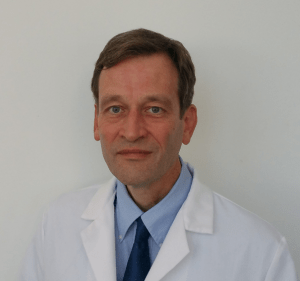
In deadly brain tumors called glioblastoma, mebendazole needed only 0.11 to 0.31 micrograms to kill cancer stem cells, while temozolomide (the standard $10,000-per-month treatment) needed 8.7 to 547 micrograms—mebendazole is up to 1,000 times more effective.
Mebendazole works by attacking the cancer stem cells' internal skeleton (tubulin) and cutting off their blood supply.
Celecoxib: The Arthritis Drug That Tames Cancer Royalty
Celecoxib, commonly used for arthritis pain, has revealed a hidden talent for destroying cancer stem cells. Unlike traditional chemotherapy that kills everything in sight, celecoxib specifically targets the cancer stem cells' communication systems. It shuts down their "prostaglandin E2" messaging system and disrupts their Wnt pathway—like cutting the phone lines in a royal palace.
In liver cancer trials, metronomic (low-dose daily) celecoxib significantly reduced tumor growth and prevented new cancers from forming. Researchers found it particularly effective at shrinking the cancer stem cell population and reducing their sphere-forming ability—a key test of stemness.
Nature's Pharmacy: The Nutrient Ninjas
Curcumin: The Golden Warrior
Curcumin, the bright yellow compound in turmeric, has been called the "master regulator" of cancer stem cells. What makes curcumin extraordinary is its ability to attack over 100 different molecular targets simultaneously—like a master martial artist fighting multiple opponents at once.
In lung cancer studies, curcumin dramatically reduced tumor blood vessel formation (angiogenesis) and stopped cancer stem cells from invading other tissues. Unlike chemotherapy that might target one pathway, curcumin attacks the JAK/STAT pathway, NF-κB signaling, and Wnt signaling all at the same time.
Clinical trials have shown that curcumin combined with standard chemotherapy works better than chemotherapy alone, while actually reducing side effects. It's like having a bodyguard that protects you while helping you fight more effectively.
EGCG: The Green Tea Guardian
EGCG, found in green tea, has shown remarkable precision in hunting down cancer stem cells. In prostate cancer studies, EGCG specifically targeted cancer stem cells while showing weaker effects on regular cancer cells—the opposite of what most treatments do.
EGCG works by disrupting the cancer stem cells' ability to transform and move (called epithelial-mesenchymal transition). It's like removing the shapeshifting abilities from enemy spies, making them easier to identify and eliminate.
Vitamin D: The Sunshine Medicine
High-dose vitamin D has produced superior clinical results compared to standard treatments in major cancer trials. The SUNSHINE trial in colorectal cancer patients showed that high-dose vitamin D (8,000 IU daily) significantly delayed disease progression when added to standard chemotherapy.
Vitamin D works by reprogramming cancer stem cell metabolism—changing how they produce energy—while simultaneously boosting the immune system's ability to recognize and attack cancer cells.
The Clinical Revolution: David Defeats Goliath
The clinical results are not just promising—they represent a fundamental shift toward superior outcomes with dramatically reduced toxicity.
The Creating Change: Why These Agents Win
These agents succeed where traditional treatments fail because they target cancer at its source—the stem cells—rather than just the symptoms (tumor bulk). They work through multiple mechanisms:
Precision Targeting: They specifically hunt cancer stem cells while sparing normal tissues
Multi-Pathway Attack: They attack multiple survival systems simultaneously
Immune Enhancement: Many boost the immune system's natural cancer-fighting abilities
Low Toxicity: They cause minimal side effects compared to chemotherapy
Resistance Prevention: They prevent the development of treatment-resistant cancer cells
The Paradigm Shift: From Barbarism to Precision
We are witnessing the greatest transformation in cancer medicine since the discovery of chemotherapy. The old paradigm of "maximum tolerated dose" toxicity is giving way to "minimum effective dose" precision.
The old way: Poison the entire body, accept massive side effects, hope to kill cancer faster than the patient
The new way: Target cancer's command structure precisely, enhance natural healing, cure without destruction
This shift is like moving from carpet bombing to laser-guided precision strikes. Instead of destroying entire cities to eliminate enemies, we can now target specific buildings while leaving neighborhoods intact.
The Nobel Prize Horizon: Recognition of Genius
The field of cancer stem cell biology is rapidly approaching Nobel Prize recognition. The discoveries that cancer stem cells drive tumor growth, that they can be specifically targeted, and that natural compounds can defeat them more effectively than synthetic drugs represent three Nobel-worthy breakthroughs.
The scientists who first identified cancer stem cells—Dr. John Dick (leukemia, 1997) and the teams who found them in solid tumors (2002 onwards)—have fundamentally changed how we understand cancer. Their work has opened the door to cures that seemed impossible just two decades ago.
The repurposed drug revolution, led by researchers discovering that humble medications like ivermectin and mebendazole can outperform billion-dollar cancer drugs, represents another Nobel-caliber achievement. These discoveries prove that nature and medical history had already provided many of the tools we needed—we just had to recognize them.
The Golden Age: Cures Without Barbarism
We stand at the threshold of the Golden Age of Cancer Medicine. For the first time in medical history, we have treatments that are:
More effective than traditional therapies
Less toxic than traditional therapies
Accessible and affordable for all patients
Capable of preventing recurrence
Able to enhance quality of life during treatment
The paradigm shift is already happening:
Clinical trials are increasingly focusing on cancer stem cell targets
Natural compounds are gaining recognition as legitimate cancer treatments
Combination therapies are replacing single-agent approaches
Prevention and cure are becoming realistic goals rather than distant dreams
Conclusion: The Phoenix Prophecy Fulfilled
The Phoenix has risen from the ashes of barbaric cancer treatments, spreading wings of hope across the medical world. The age of poisoning patients to save them is ending. The age of precision healing, natural wisdom, and actual cures is beginning.
What started as whispered discoveries in research laboratories—that humble soil bacteria medicines and kitchen spices could defeat humanity's most feared disease—has grown into a revolutionary movement that will define 21st-century medicine.
The repurposed drug revolution marches on, led by an unlikely army of livestock dewormers, arthritis pills, curry spices, and green tea compounds. Each clinical trial, each successful treatment, each life saved adds another chapter to the greatest medical story ever told: how humanity learned to cure cancer without destroying the patient.
The Nobel Prizes are coming. The recognition will flow to the brilliant scientists who dared to look beyond expensive synthetic drugs and billion-dollar research programs to find healing in nature's simple gifts. But more importantly, the cures are coming.
Cancer patients of the future will look back at chemotherapy and radiation like we now look back at medieval bloodletting and trepanation—as primitive attempts at healing by people who meant well but lacked understanding. They will receive their cancer treatments in comfortable outpatient clinics, taking pills derived from turmeric and green tea, medicines originally developed for farm animals, and nutrients that support rather than destroy their bodies.
The Phoenix prophecy is being fulfilled before our eyes: from the ashes of toxic medicine, a new healing paradigm rises—one where cures are not just possible but commonplace, where treatment enhances rather than destroys life, and where cancer becomes not a death sentence but a conquerable challenge.
The sleeping giant has awakened. The revolution is here. The cures are coming.
Clinics where Integrative Oncology Care May Be Obtained
While no center is yet providing complete ROOT™ Protocol treatment as the studies are currently in press, we have received many requests for a list of clinics or clinicians that utilize many of these repurposed drugs and agents - like Ivermectin and Mebendazole - in their practices. I am thrilled to provide all my readers with such integrative clinics in every area of the nation, including Hawaii and Alaska.
Below is a list of 17 such clinics where one can find practitioners willing to prescribe Ivermectin, Mebendazole, or various other agents of the ROOT™ protocols.
Keep reading with a 7-day free trial
Subscribe to Repurposed Drugs: Powers & Possibilities to keep reading this post and get 7 days of free access to the full post archives.


